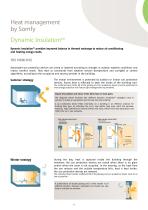
Catalog excerpts

Somfy solutions for the development of Bioc limatic Faç ade s
Open the catalog to page 1
The challenges of bioclimatic façades In our modern day, designing and renovating a building has become more and more complex. Climate change and the necessity to reduce CO2 emissions have created new challenges which have strongly impacted the conventional rules in the building industry. To achieve those challenges, building professionals have to work closer together in an integrated approach focusing on two major concerns: how to improve the energy performance of buildings and provide occupants with maximum comfort. Applying the principles of bioclimatic design in a building is a proven...
Open the catalog to page 2
Meeting current environmental requirements Buildings alone are responsible for 43 % of energy consumption in Europe! It is now essential to reduce this figure by promoting the use of natural energy sources such as sunshine, daylight and outside air. Automated solar shading and window opening devices integrated within the façade help to optimise the use of natural sources and therefore contribute to increasing the energy efficiency in buildings. Improving the quality of indoor environments Another major goal of modern building specifications is enhancing the quality of the indoor...
Open the catalog to page 3
San Francisco Federal Building, US Architect: Morphosis & Smith Group Inc. The effectiveness of bioclimatic façades A façade designed following bioclimatic principles is more efficient than a standard façade as it works as a dynamic filter between the indoors and the outdoors. Windows fitted with automated sun protection devices can filter unwanted sunlight and regulate heat exchanges, in tune with the needs of the building occupants. To achieve a high level of performance from the façade, designers must pay close attention to the building’s environment and the day-to-day activities of...
Open the catalog to page 4
The occupants’ activity and how the building is used Occupation density and rate as well as the amount of natural light required for the activities carried out inside the building are just some of the many criteria that influence how interior space is organised and the choice of systems used. Changes in indoor requirements according to the building use Occupants Equipment Lighting Residential buildings Occupants 5W/m2 Equipment 15W/m2 Lighting 10W/m2 Occupants 22W/m2 Equipment 15W/m2 Lighting 30W/m2 Sport / leisure Source: Keepcool, Austrian energy agency Choosing the components in the...
Open the catalog to page 5
How Somfy contributes to bioclimatic façades For 40 years, Somfy has been developing intelligent solutions for building openings and closings, using high-tech motorisation and automation systems. Dynamic InsulationTM, daylight management and natural ventilation: are Somfy’s three unique areas of expertise dedicated to the development of bioclimatic façades. Natural light management Dynamic InsulationTM Better control of natural light and improved visual comfort. Improved balance in thermal exchange to reduce HVAC systems energy consumption. Natural ventilation For a more pleasant,...
Open the catalog to page 6
Dynamic insulationTM Windows are the main interface between the interior and exterior of a building. A façade fitted with sun protection devices can provide precise control over these exchanges, influencing the way in which heat enters and leaves the building. Solar shading devices which are raised and lowered automatically will keep the inside of a building cool or optimise the use of solar gain. For more details, see pages 4-5 Natural light management Effective natural light management can improve the visual comfort, well-being and productivity of a building’s occupants, while reducing...
Open the catalog to page 7
Heat management by Somfy Dynamic Insulationtm Dynamic InsulationTM provides improved balance in thermal exchange to reduce air conditioning and heating energy needs. THE PRINCIPLE Automated sun protection devices are raised or lowered according to changes in outdoor weather conditions and indoor comfort needs. They react to commands from weather sensors (temperature and sunlight) or control algorithms, according to the occupancy and vacancy periods in the building. Summer strategy The indoor environment is protected by outdoor or indoor sun protection devices. Excess heat is reflected to...
Open the catalog to page 8
RESULTS Thermal comfort and an improved indoor environment With Dynamic InsulationTM, the building’s occupants are no longer subjected to sudden variations in temperature. Constant thermal comfort helps to improve day-to-day well-being. Improved energy performance With automated sun protection devices, it is possible to anticipate a particular building’s energy consumption level. All cooling, heating, lighting and blind management systems are fully integrated and communicate with each other to maximize energy efficiency. Impact of automated sun protection devices on energy consumption...
Open the catalog to page 9
Natural light management by Somfy visual comfort Providing visual comfort indoors while enabling occupants to see the outside world has a positive effect on their well-being. Using natural light first and controlling the use of artificial lighting also has a beneficial impact on energy consumption. THE PRINCIPLE Indoor visibility is a key factor in the occupants’ sense of comfort. In order to maintain an optimal visual environment, automated solar shadings must ensure specific functions. Control algorithms do take many parameters into account in order to provide occupants with: - a maximum...
Open the catalog to page 10
RESULTS A more comfortable workspace With automated sun protection devices building occupants benefit from more natural light without the associated disadvantages. The ideal levels of contrast and brightness are maintained at all times. Excessive glare is eliminated. Energy savings on artificial lighting Lighting accounts for a significant portion of a building’s total electricity consumption and energy costs (35% on average). With automated sun protection devices, this cost can be reduced significantly, yet users are able to retain their individual preferences. Energy consumption 10%...
Open the catalog to page 11All Somfy Architecture catalogs and technical brochures
-
Education store
5 Pages
-
Animeo Range
69 Pages
-
Animeo Range Overview
8 Pages
-
animeo & VarioSys
69 Pages
-
Somfy Bioclimatiques Façades
1 Pages







